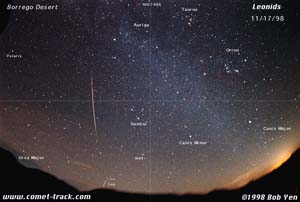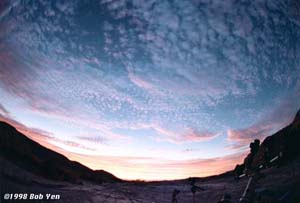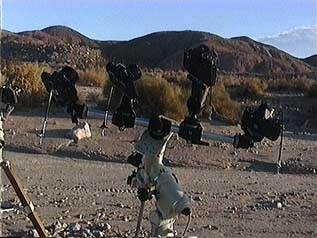





I used 14 cameras (4 time-lapse, wide-angle to semi-telephoto, 35mm & 6x7) spread over 3 GEMs/2 tripods. Also, a low-light B&W video camera on another tripod. I've put some preliminary images at: http://www.comet-track.com/meteor/leonids98/leonids98.html Check back over the next 2 weeks, I have 18 rolls of film to go through. (8 of them are 36 frame time-lapses, so that's at least 8x36=288 frames to scan). I haven't even looked at the video yet. The medium-format stuff is KILLER. However, scans are $10 a piece for 1 week turnaround. Because of the $$ cost, I'm afraid most of them will never get posted. Too bad!!
I am not particularly a meteor photography specialist, & just whipped up a program at the last minute (I didn't finalize my procedure until 3:30 am, Monday morning). Main thing, was to go & buy TEN cable releases (in addition to the 10 I already have).
Man, what a FIREBALL show it was.. BEST meteor shower I've seen in my life (echoing other peoples accounts). I had to get everything set up, by 11 pm, the 1st window of opportunity for Leonids. Right at 11:10pm PST, I see this FIREBALL coming low from the east & go right over the zenith towards the west. Real slow, I could see the pinpoint nucleus, halo (elliptically shaped), light-green color. I saw it the WHOLE way, AMAZED at this rare spectacle -- one of the memorable moments of my life. Remember that daylight fireball back in the 60's/70's?) (someone got it on movie film, & stills were published in Sky&Tel). This is what I saw: it moved steadily across the sky, not a typical < 1 sec meteor. WOW. I mean, I just started my cameras few minutes ago, & this thing comes right at me (I was looking east), goes overhead,.. Trippy.. I KNEW this would be a GOOD night. (I had seen a couple like this before, but without the eyeball account of the nucleus -- a Perseid from Mt. Pinos in '93 (?) & Mt. Wilson back in '85 (however, both were low & moving slow).
Many times I detected flashes on the ground, which indicated an exceptional fireball. (I was REAL busy running 14 still cameras & 1 video camera, didn't have a chance to lie back & enjoy the show). I caught a lot of meteors near the radiant, one 6x7 frame shows 8 meteors! (over 10 min) As others observed, during the 3-5am period, there was a LOT of activity AWAY from the radiant. Towards the West (near Orion, Pleiades, overhead in Auriga) & SouthWest (Canis Major). Early on (around midnight), I noticed a lot of activity near Ursa Major (I caught some on film, after re-adjusting my program to shoot in that direction). I.e., I saw meteors ALL over the sky. (I was advised to concentrate on a 40 degree radius around the radiant. Wrong!). I did notice the "clustering" effect, where there were 2 in quick succession (near the handle of Big Dipper & near the Pleiades).
In the above URL, I have images of this 50 degree fireball @11:40pm (got it on the 7.5mm, 16mm, 20mm, 14mm, 50mm cluster). The 7.5mm circular fisheye even got a 60 degree fireball, ending with a big flash. I shot on color, and ALL the pictures demonstrates the following characteristics for meteor trails:
- initial trail is green, midway & end has a red-component - the fore-shortened fireballs near the radiant had a different "feel", like they were "brighter" (since the light of the fore-shortened meteor is integrated over a smaller area)
Many fireballs left smoke-trails, which could be seen naked eye. Very obvious in 7x50 binoculars. I used the low-light B&W video camera for imaging their dispersion. I photographed one (see above URL) with still camera, it spanned 10 degrees.
There was this one fireball, very near the radiant (Zeta-Leo). It's debris-trail is BIZARRE looking, it looks like there is a separate trail at the terminus & apex (where the trail is the "fattest", i.e. location of "explosion"). I'd like some scientists (meteor specialists) to look at these images, & help me out with some interpretation.
I had some minor cloud interference (quickly moving bands of thin clouds) around 4am. The next day, Monday evening/Tuesday morning (17/18) looked to be absolutely CLEAR, but it was windy (high-pressure was building over the basin). My cameras were getting sand blasted, & I didn't feel like going through another TORTURE session (firing 13 cameras EVERY 10 min, for 6 STRAIGHT hours. Man, was I WASTED). That would have meant 18 more rolls of film, & the $$ cost for film developing was getting to be a bit prohibitive.. So, I cut for home. (According to s.a.a. reports, Leonids apparently died out anyway.)
I had a good time! I learned a lot about how to cover a meteor shower. Next time, I will do better! I caught some TV coverage when I got back, they showed a Japanese amateur with an array of cameras on a Takahashi mount. I swear, it was a mirror of my setup (I was using 2 Tak mounts myself)
 Click for HI-RES image |
UNDER CONSTRUCTION: come back until Dec 1 for additional images & |